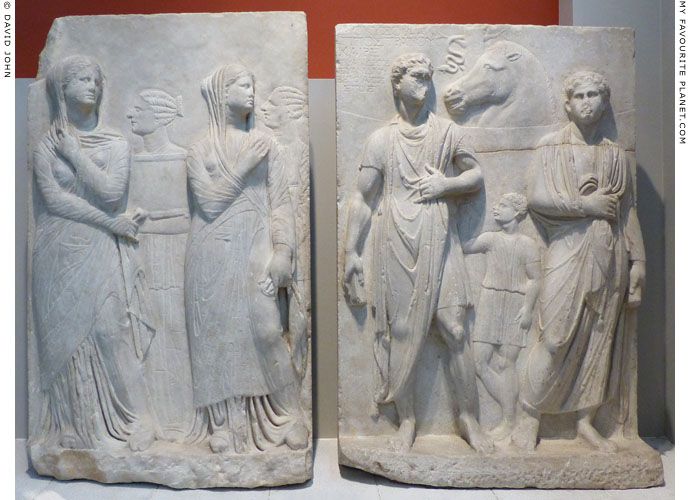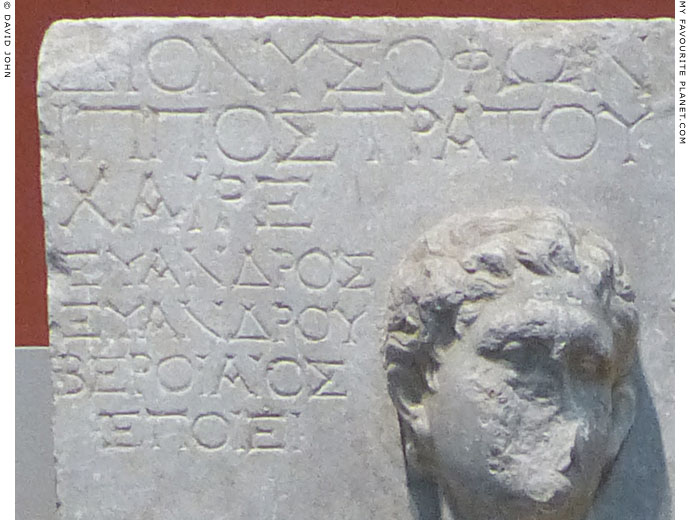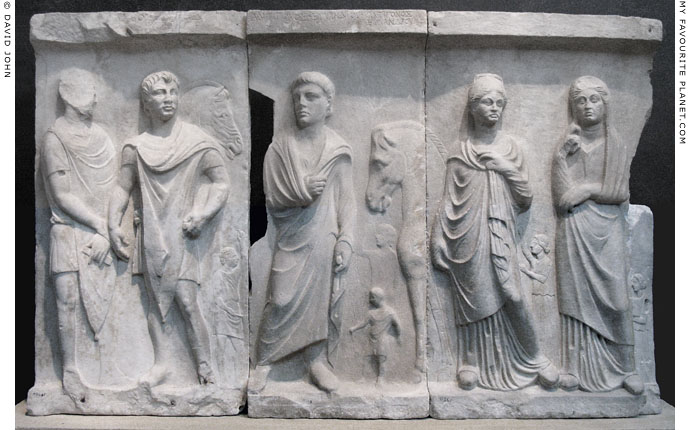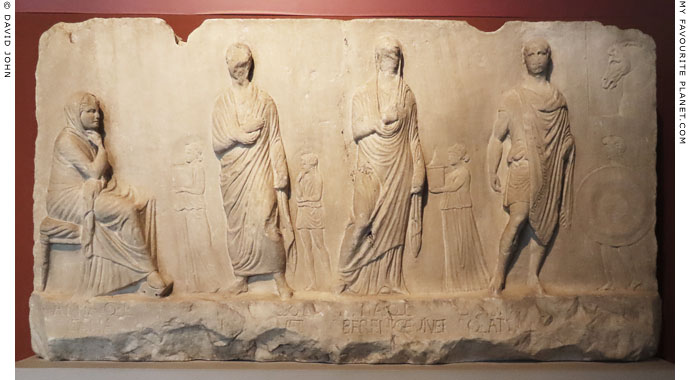|
|
|
| My Favourite Planet > English > People > Evandros of Veroea |
 |
back |
Evandros of Veroea |
|
|
| |
Evandros of Veroea
Ancient Greek mythology, religion and art
Evandros of Veroea (Εὔανδρος, Euandros, also referred to as Evander of Veroea) was a sculptor from Veria (Βέροια, Beroea), Macedonia, working in the second half of the first century BC. He was the son of Evander of Veroea, and possibly the father of Adymos of Veroea.
It is thought that Evandros and Adymos belonged to a family of sculptors who undertook commissions around Macedonia and Thessaly. They both made grave monuments and, unusually, signed their name on them; most sculptors of the time remain anonymous. This suggests that they had a high reputation in the region.
The remains of two grave monuments with reliefs signed by Evandros have been discovered in northern Greece:
1. The marble grave stele of Dionysophon, son of Hippostratos, was discovered in 1945 at the necropolis of the ancient Mygdonian city of Lete, at Derveni, northeast of Thessaloniki. See photos and details below.
2. Part of a cylindrical marble base of a grave monument with a relief bust of a woman (the face is destroyed), found at Pelasgiotis, Larissa, Thessaly. The inscription:
Εὔανδρος Εὐάνδρου Βεροιαῖος ἐποίε[ι].
Evandros, son of Evandros, of Veroea made it.
Inscription IG IX,2 601. Larissa Archaeological Museum.
See:
E. Voutiras, in G. Despinis, Th. Stephanidou-Tiveriou and E. Voutiras, Catalogue of sculpture in the Archaeological Museum of Thessaloniki, I, pages 85-87, illustrations 138 and 139. Thessaloniki, 1997. In Greek, Κατάλογος γλυπτών του αρχαιολογικού μουσείο θεσσαλονίκης II, 2003.
Ariane Elisabeth Tatas, Die figürlichen Grabstelen im römischen Thessaloniki, pages 17 and 134 and Abbildungen (photos) 1 and 2. MA thesis. Ruprecht-Karls-Universität Heidelberg, 2009. (PDF document)
Peter Robert Franke, Zwei signierte Werke des Bildhauers Euandros. ΘΕΣΣΑΛΙΚΑ, Neue Folge, 101, Band 4. H. (1958), pages 336-338. Rheinisches Museum für Philologie. J. D. Sauerländers Verlag, 1958. |
| |
| |

Two marble slabs with reliefs from a funerary monument. The top left corner of the slab
on the right is inscribed with the signature of Evandros of Veroea (see photo below).
From the cemetery of Derveni (area of ancient Lete), Macedonia, Greece. Mid 1st century BC.
Thessaloniki Archaeological Museum. Inv. No. 1935A and 1935B.
|
The marble grave stele of Dionysophon, son of Hippostratos, discovered in 1945 at the necropolis of the ancient Mygdonian city of Lete (Λητή), at Derveni, northeast of Thessaloniki. The stele was found in two parts, in good condition, each with well-sculpted, detailed reliefs. The monument had been reused for a Christian grave.
The relief on the left slab shows two standing women, wearing cloaks, part of which cover the top of their heads (i.e. "veiled"). Their heads are turned to the right to face the men on the other side of the relief. Behind them stand two smaller female servants, in profile facing left, carved in lower relief and in a different, more schematic style.
The relief on the right slab shows to young men facing forwards. Between them is a smaller boy servant, above whose head is the head of a horse in profile facing left and a tree with a snake (typical symbols of hero reliefs). The Inscription at the top left of the slab states:
Διονυσοφῶν Ἱπποστράτου χαῖρε.
Εὔανδρος Εὐάνδρου Βεροιαῖος ἐποίει.
Dionysophon, son of Hippostratos, greetings.
Evandros, son of Evandros, of Veroea made it.
Inscription SEG 17:318.
Left slab with two women, Inv. No. 1935A. Height 130 cm, width 82/78 cm, depth 6,5 cm.
Right slab with two men, Inv. No. 1935B. Height 129 cm, width 89/83 cm, depth 6,5 cm. |
|
|
| |

The inscription on the top left corner of the right
slab, with the signature of Evandros of Veroea. |
| |

A large, unsigned marble funerary monument from Derveni, dedicated
by Antigonos, son of Evlandros (Ἀντίγονος Εὐλάνδρου). Circa 30 BC.
Thessaloniki Archaeological Museum. Inv. No. Inv. Nos. 1934A, 1934B, 1934Γ.
|
Like the stele signed by Evandros, this funerary monument was discovered in 1945 at the necropolis of Lete at Derveni, and had also been reused for a Christian grave. It is in three parts, in good condition, apart from a missing head on the left slab and parts of the edges of the middle and right slab.
Although the iconography and composition of the relief are similar to that of the stele by Evandros, and typical of the period, the style and treatment of the figures are quite different.
The relief on the left and middle slab show three standing male figures in cloaks, perhaps sons of Evlandros. The figure on the left faces the other two who face forwards. Behind the central figure is a horse facing right, and between him and the right-hand figure is a much smaller male servant, apparently holding the reigns of the horse. The face of the right-hand figure has been sculpted in a decidedly different style to the other main figures on the stele. On the right of the middle slab is part of a horse facing left, which continues on the right slab. Below the horse's head are two small male servants.
On the right slab two standing females in cloaks face forward. Between and to the right of them are small female servants. The servants and horses are in lower relief than the five main figures.
Inscriptions on the left and middle slabs run across the top ledge of the stele. The inscription on the left slab is fragmentary.
Left slab:
[– –]αιος Εὐλάνδ[ρου],
[– – – – –]Ρ[– – –]εύς·
Middle slab, left:
Ἀντίγονος Εὐλάνδρου
Middle slab, right:
Ἀντίγονος
Εὐλάνδρου
Inscription SEG 47:905.
Height of stele 139 cm, depth 21 cm. |
|

One of the women on the stele
dedicated by Antigonos. |
|
| |

The inscription on the top right edge of the middle slab of the funerary monument
dedicated by Antigonos, son of Evlandros, with the name written twice.
Thessaloniki Archaeological Museum. Inv. No. 1934B. |
| |

An inscribed marble slab of a funerary monument from Thessaloniki, circa 50 BC.
According to the inscription, only part of which has survived, the relief depicts four
members of a family of freedmen, perhaps former slaves of a Roman merchant.
Behind them four of their slaves are shown in profile, at a smaller scale and in
lower relief. In the top right corner is the head of a horse in profile facing left.
Thessaloniki Archaeological Museum. |
| Photos and articles © David John 2008 - 2017 |
 |
Visit the My Favourite Planet Group on Facebook.
Join the group, write a message or comment,
post photos and videos, start a discussion... |
|
|
| |
|
|
| |
| |
 |
| |
 |
| |
 |
| |
 |
| |
 |
| |
 |
| |
George Alvanos
rooms in
Kavala's historic Panagia District
Anthemiou 35,
Kavala, Greece
kavalarooms.gr
|
| |
Olive Garden Restaurant
Kastellorizo,
Greece
+30 22460 49 109
kastellorizo.de
|
| |
Papoutsis
Travel Agency
Kastellorizo,
Greece
+30 22460 49 286
greeklodgings.gr
|
| |
|